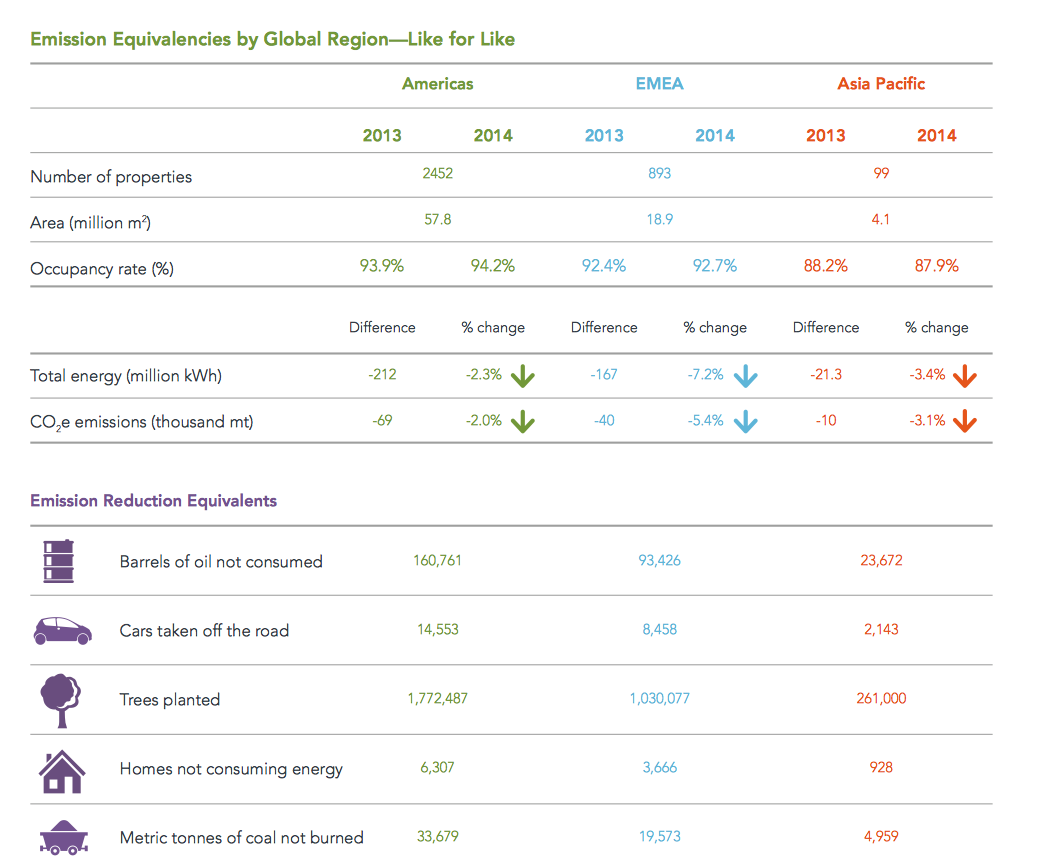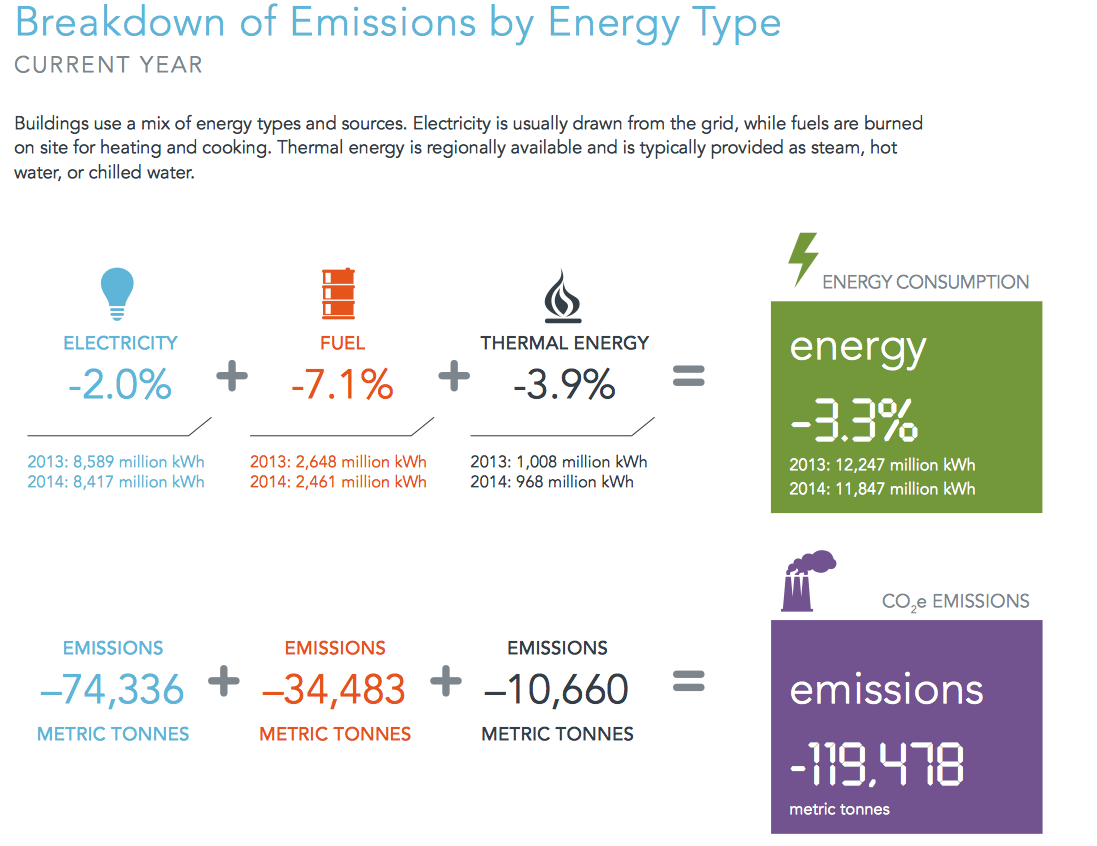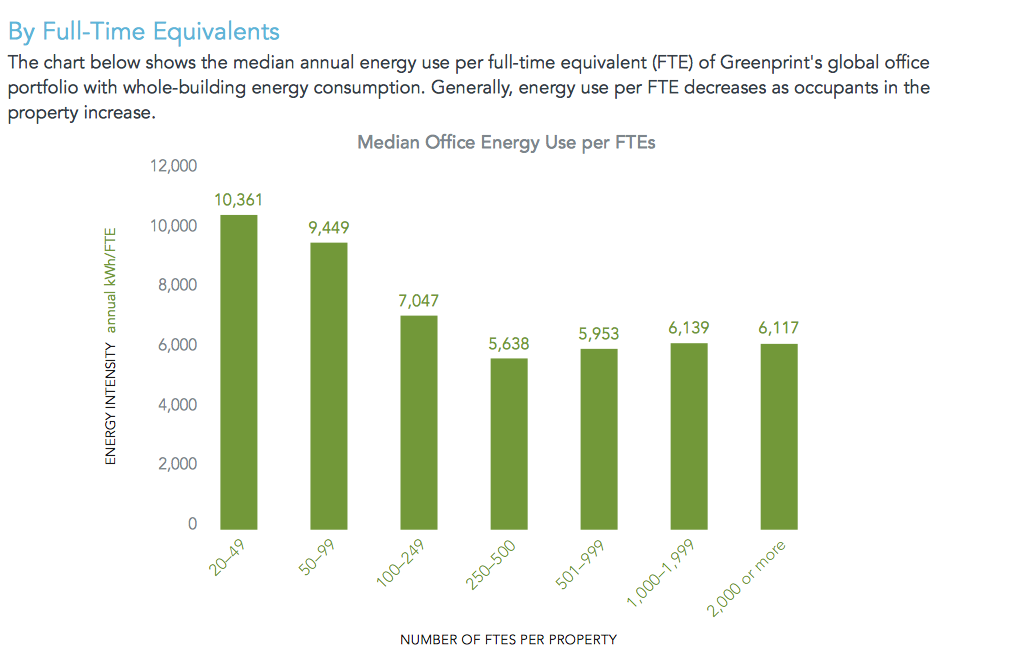Leading real estate companies are achieving incrementally significant reductions in their properties’ energy and water consumption and greenhouse gas emissions, according to the latest Greenprint Performance Report, released by the Urban Land Institute’s Greenprint Center For Building Performance.
This is the sixth annual report from the Greenprint Center, a worldwide alliance of real estate owners, investors, and strategic partners. Greenprint and its members are striving to reduce global greenhouse gas emissions by 50% by 2030. From 2009 through 2014, Greenprint’s membership grew by 140% to 36, and the properties being tracked increased by 768% to 5,224 buildings with 1.2 billion sf in 51 countries.
Over that five-year span, the energy consumption of members’ buildings fell by 11%, carbon emissions by 10.8%, the cost of energy by 4.5%, of electricity by 12.7%, and of water by 9%. Between 2013 and 2014 alone, members reported a 3.3% lowering in energy consumption to 11.8 billion kWh, a 2.7% reduction in greenhouse gas emissions to 4.3 million metric tons; a 2% decrease in electricity to 8.4 billion kWh; and a 1.9% reduction in water use to 54.5 million kiloliters (14.3 million gallons).
Greenprint notes that energy use and emissions reductions in the latest year tracked were equivalent to 277,856 barrels of oil not consumed, 25,153 cars taken off the road, 10,901 homes not consuming energy, 3,063,538 trees planted, or 58,211 metric tons of coal not burned.

While these reductions are laudable, the report doesn’t sugarcoat the magnitude of the challenge lying ahead for a world—and by implication the real estate and AEC industries: Carbon dioxide in the air is at stratospheric levels globally. 2014 was the warmest year since temperatures were first measured in 1880.
As a result, “Sea level, as observed by satellites over the past 20-plus years, has risen by about 75 millimeters (2.95 inches), adversely affecting coastal cities, infrastructure, and the environment globally.”
The report notes, too, that more than half of the world’s population currently lives in urban areas, and that the built environmental produces up to 75% of greenhouse gas emissions in cities. And by 2025, over 1.8 billion people could be living in countries with “absolute water scarcity,” and two-thirds of the world’s population could be living under water-distressed conditions.
The report breaks down its members’ performance data geographically (The Americas, Europe/Middle East/Africa (EMEA), and Asia Pacific), and by industry sector: office (which accounted for 37% of total square footage tracked in 2013-2014), retail (14%), industrial (27%), multifamily (17%), and hotels (5%). The report includes performance data showing the extent that members’ buildings are lowering their waste and improving the biodiversity within their communities.
For each sector, the report offers prescriptive advice by way of case studies, some of which were effective without being all that expensive. The developer/builder AvalonBay replaced 3,575 toilets in 2,546 of its apartments in California, and saved 4.2 million gallons of water per year. In 2015, AvalonBay instituted a California water task force to bring water-efficient projects to scale and support residential engagement and education.

The Starwood W Retreat and Spa Maldives replaced its old air-conditioning system with efficient inverter-type AC units for staff accommodations and variable-refrigerant-flow units for guest villas and the spa. The resort installed heat-recovery fixtures that use generator waste heat to provide continuous hot water. It upgraded room lighting to LEDs and replaced 50 TVs with more efficient LED sets. It installed motion sensors to operate lights and exhaust fans. And it used power analyzer meters for each energy distribution area. Starwood’s total investment of $1,448,392 resulted in a 25% reduction in peak energy load, a 42% reduction in generator running hours (for the years 2011-2014), and $313,051 in diesel oil cost savings for the period 2013-2014.
Greenprint also singles out City National Plaza in Los Angeles, two 52-story office towers and one 40-story pavilion building. Its owner Commonwealth Partners took a holistic approach to upgrading the environmental performance of the property by making improvements to energy, water, indoor air quality and transportation. It now uses sustainable cleaning products for 98% of the building’s area. And it installed high performance filtration equipment and entry mats to mitigate environmental contaminants. The complex reduced its energy consumption by 38%, its water consumption by 40%, and is achieving annual savings of $4.3 million. The buildings’ proximity to mass transit allows an average of 600 passengers to be diverted to public transportation via natural gas fueled shuttles.
On the emissions front, the retrofit, by property manager Grosvenor, of an 811-sf multifamily building in London to Passivhaus EnerPhit standards—which included upgrading to more efficient ventilation, new triple-glazed mock sash windows, and improved insulation and airtightness—is expected to reduce tenants’ energy consumption by 80%, and to cut emissions by 840,000 kilograms—the equivalent of 1,900 barrels of oil not consumed—over the 60-year life of the property.
Bentall Kennedy, which manages two medical office buildings in San Antonio, consolidated quarterly HVAC maintenance under one vendor, retrofitted the building automation system with an interface that allowed better labeling and scheduling, and negotiated a new energy price contract. A $20,460 investment is projected to result in a 25% annual reduction in GHG emissions, and $558,384 in savings over 10 years.



Related Stories
| Oct 30, 2014
CannonDesign releases guide for specifying flooring in healthcare settings
The new report, "Flooring Applications in Healthcare Settings," compares and contrasts different flooring types in the context of parameters such as health and safety impact, design and operational issues, environmental considerations, economics, and product options.
| Oct 29, 2014
Better guidance for appraising green buildings is steadily emerging
The Appraisal Foundation is striving to improve appraisers’ understanding of green valuation.
| Oct 27, 2014
Report estimates 1.2 million people experience LEED-certified retail centers daily
The "LEED In Motion: Retail" report includes USGBC’s conceptualization of the future of retail, emphasizing the economic and social benefit of green building for retailers of all sizes and types.
| Oct 27, 2014
Top 10 green building products for 2015
Among the breakthrough products to make BuildingGreen's annual Top-10 Green Building Products list are halogen-free polyiso insulation and a high-flow-rate biofiltration system.
| Oct 21, 2014
Inside LEED v4: The view from the MEP engineering seats
Much of the spirited discussion around LEED v4 has been centered on the Materials & Resources Credit. At least one voice in the wilderness is shouting for greater attention to another huge change in LEED: the shift to ASHRAE 90.1-2010 as the new reference standard for Energy & Atmosphere prerequisites and credits.
| Oct 16, 2014
Perkins+Will white paper examines alternatives to flame retardant building materials
The white paper includes a list of 193 flame retardants, including 29 discovered in building and household products, 50 found in the indoor environment, and 33 in human blood, milk, and tissues.
| Oct 16, 2014
48 building professionals in 2014 class of LEED fellows
To be selected, LEED Fellows are nominated by their peers, undergo an extensive portfolio review, must have at least 10 years of experience in the green building industry and hold a LEED AP with specialty credential, among other requirements.
| Oct 15, 2014
Harvard launches ‘design-centric’ center for green buildings and cities
The impetus behind Harvard's Center for Green Buildings and Cities is what the design school’s dean, Mohsen Mostafavi, describes as a “rapidly urbanizing global economy,” in which cities are building new structures “on a massive scale.”
| Oct 14, 2014
USGBC awards individuals, firms for leading the way in sustainable construction
This year’s Leadership Award recipients include Christine Ervin, David Orr, Jim DeCesare, Lloyd Alter, Tom Paladino, The Near Westside Initiative, and Mars, Inc.
| Oct 2, 2014
11 projects receive Affordable Green Neighborhoods grants from BoA, USGBC
Each of these neighborhood redevelopment projects are notable for their planned affordable housing, compact design, commitment to green building and sites located near transit or other existing amenities.
















